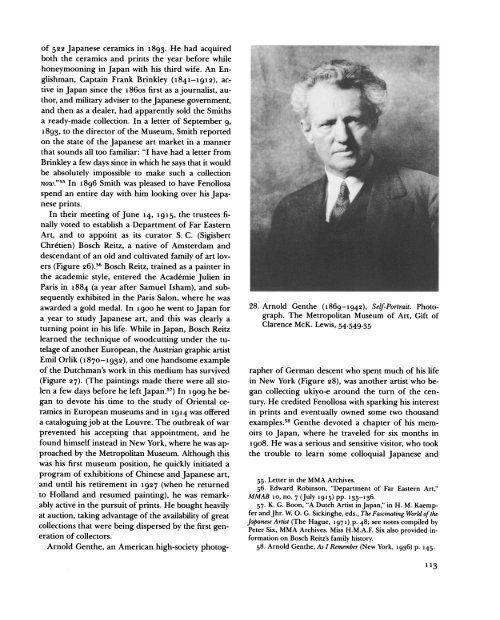Early Collectors of Japanese Prints and The Metropolitan Museulm ...
Early Collectors of Japanese Prints and The Metropolitan Museulm ...
Early Collectors of Japanese Prints and The Metropolitan Museulm ...
You also want an ePaper? Increase the reach of your titles
YUMPU automatically turns print PDFs into web optimized ePapers that Google loves.
<strong>of</strong> 522 <strong>Japanese</strong> ceramics in 1893. He had acquired<br />
both the ceramics <strong>and</strong> prints the year before while<br />
honeymooning in Japan with his third wife. An Englishman,<br />
Captain Frank Brinkley (1841-1912), active<br />
in Japan since the 186os first as a journalist, author,<br />
<strong>and</strong> military adviser to the <strong>Japanese</strong> government,<br />
<strong>and</strong> then as a dealer, had apparently sold the Smiths<br />
a ready-made collection. In a letter <strong>of</strong> September 9,<br />
1893, to the director <strong>of</strong> the Museum, Smith reported<br />
on the state <strong>of</strong> the <strong>Japanese</strong> art market in a manner<br />
that sounds all too familiar: "I have had a letter from<br />
Brinkley a few days since in which he says that it would<br />
be absolutely impossible to make such a collection<br />
now."55 In 1896 Smith was pleased to have Fenollosa<br />
spend an entire day with him looking over his Japa-<br />
nese prints.<br />
In their meeting <strong>of</strong> June 14, 1915, the trustees fi-<br />
nally voted to establish a Department <strong>of</strong> Far Eastern<br />
Art, <strong>and</strong> to appoint as its curator S. C. (Sigisbert<br />
Chretien) Bosch Reitz, a native <strong>of</strong> Amsterdam <strong>and</strong><br />
descendant <strong>of</strong> an old <strong>and</strong> cultivated family <strong>of</strong> art lov-<br />
ers (Figure 26).56 Bosch Reitz, trained as a painter in<br />
the academic style, entered the Academie Julien in<br />
Paris in 1884 (a year after Samuel Isham), <strong>and</strong> sub-<br />
sequently exhibited in the Paris Salon, where he was<br />
awarded a gold medal. In 1900 he went to Japan for<br />
a year to study <strong>Japanese</strong> art, <strong>and</strong> this was clearly a<br />
turning point in his life. While in Japan, Bosch Reitz<br />
learned the technique <strong>of</strong> woodcutting under the tu-<br />
telage <strong>of</strong> another European, the Austrian graphic artist<br />
Emil Orlik (1870-1932), <strong>and</strong> one h<strong>and</strong>some example<br />
<strong>of</strong> the Dutchman's work in this medium has survived<br />
(Figure 27). (<strong>The</strong> paintings made there were all sto-<br />
len a few days before he left Japan.57) In 1909 he be-<br />
gan to devote his time to the study <strong>of</strong> Oriental ce-<br />
ramics in European museums <strong>and</strong> in 1914 was <strong>of</strong>fered<br />
a cataloguing job at the Louvre. <strong>The</strong> outbreak <strong>of</strong> war<br />
prevented his accepting that appointment, <strong>and</strong> he<br />
found himself instead in New York, where he was ap-<br />
proached by the <strong>Metropolitan</strong> Museum. Although this<br />
was his first museum position, he quickly initiated a<br />
program <strong>of</strong> exhibitions <strong>of</strong> Chinese <strong>and</strong> <strong>Japanese</strong> art,<br />
<strong>and</strong> until his retirement in 1927 (when he returned<br />
to Holl<strong>and</strong> <strong>and</strong> resumed painting), he was remark-<br />
ably active in the pursuit <strong>of</strong> prints. He bought heavily<br />
at auction, taking advantage <strong>of</strong> the availability <strong>of</strong> great<br />
collections that were being dispersed by the first gen-<br />
eration <strong>of</strong> collectors.<br />
Arnold Genthe, an American high-society photog-<br />
28. Arnold Genthe (1869-1942), Self-Portrait. Photo-<br />
graph. <strong>The</strong> <strong>Metropolitan</strong> Museum <strong>of</strong> Art, Gift <strong>of</strong><br />
Clarence McK. Lewis, 54.549.35<br />
rapher <strong>of</strong> German descent who spent much <strong>of</strong> his life<br />
in New York (Figure 28), was another artist who be-<br />
gan collecting ukiyo-e around the turn <strong>of</strong> the cen-<br />
tury. He credited Fenollosa with sparking his interest<br />
in prints <strong>and</strong> eventually owned some two thous<strong>and</strong><br />
examples.58 Genthe devoted a chapter <strong>of</strong> his mem-<br />
oirs to Japan, where he traveled for six months in<br />
1908. He was a serious <strong>and</strong> sensitive visitor, who took<br />
the trouble to learn some colloquial <strong>Japanese</strong> <strong>and</strong><br />
55. Letter in the MMA Archives.<br />
56. Edward Robinson, "Department <strong>of</strong> Far Eastern Art,"<br />
MMAB io, no. 7 (July 1915) pp. 135-136.<br />
57. K. G. Boon, "A Dutch Artist in Japan," in H. M. Kaempfer<br />
<strong>and</strong> Jhr. W. O. G. Sickinghe, eds., <strong>The</strong> Fascinating World <strong>of</strong> the<br />
<strong>Japanese</strong> Artist (<strong>The</strong> Hague, 1971) p. 48; see notes compiled by<br />
Peter Six, MMA Archives. Miss H.M.A.F. Six also provided in-<br />
formation on Bosch Reitz's family history.<br />
58. Arnold Genthe, As I Remember<br />
(New York, 1936) p. 145.<br />
113

















